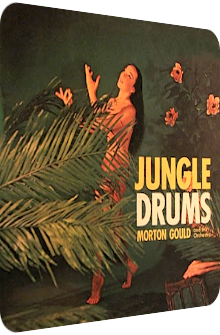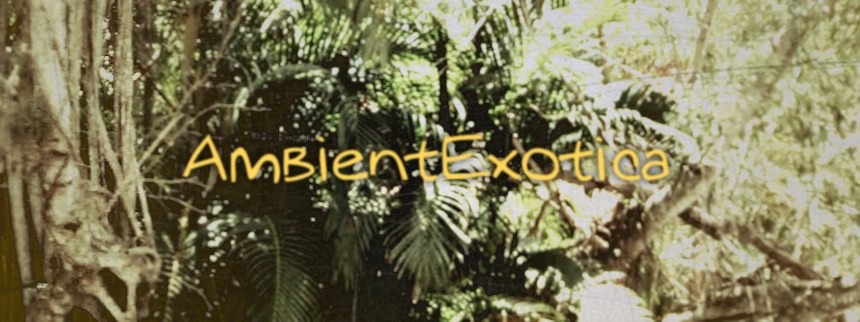
Morton Gould
Jungle Drums
1957
If there is one conductor who was able to quickly adjust to the sudden rise of the Exotica genre in 1957, it has to be Morton Gould (1913–1996), as his 1957 opus Jungle Drums, released on RCA Victor, is not only released in the same year Martin Denny’s Exotica launched the music-related genre of a faux-primitive lifestyle, no, Gould comes up with another achievement: a whopping 15 arrangements are featured on this LP, 14 of them being takes on well-known and successively rediscovered classics, and one being Gould’s own contribution to the genre, the vivacious Tropical which itself has then been considered by many other Exotica quartets, Jazz combos and in orchestral settings.
Be that as it may, Jungle Drums succeeds on so many levels that it is anything but awe-inspiring. No included composition feels like an afterthought, and as the album progresses, the stylistic and instrumental range only widens. Of particular interest at first glance seems to be side A since it contains eight tunes written by Ernesto Lecuona. This Latin suite is surprisingly complex, for its many colorful melodies are in a constant dialog with quieter improvisations.
One might think that Gould puts forth all his efforts on side A and throws in a few other tunes on side B for he has to offer something on side B, right? The opposite is the case! Side B marks the real exotic start of the album, with intermixed field recordings on two arrangements, one remarkable percussion-based imitation of a train (one year before Martin Denny accomplished this on his LP Primitiva), an Oriental setup for a change and tremendously wild and teeming brass concoctions, flute whirlwinds and violin vesicles which meet and depart time and again. The scope of the production is large, with only one particular downside in regard to the title of the album, as the jungle drums are solely comprising of the otherwise well-established timpani which are ubiquitously used in virtually every large orchestra anyway. Despite the omission of bongos and guiros, Jungle Drums has a lot to offer; Morton Gould is capable of delivering a truly beautiful plastic jungle panorama. In the following paragraphs, I am trying to prove this assertion.
The gateway to the jungle leads to the eight-piece suite of Ernesto Lecuona. Not only does Gould choose the material wisely, it can also serve as teaching material for use in a (non-existing) Exotica school, as both Lecuona’s gold standards and lesser known genre-related compositions are tied together on side A. The eponymous Jungle Drums launches with a menacing, pompously droning timpani solo with an eerie decay; it is after 30 seconds into the take that the mood shifts to a majestic but lush greenery due to brass flourishes, trembling orchestra strings and paradisiac flutes. The permanent oscillation between mellifluous flute-focused sections and fulminant attacks lead to a dynamic orchestra piece whose main melody is realized with warped Space-Age strings.
After a final elephant-like brass eruption, La Comparsa follows, a mellow tune of a quiescent mystique due to the carefully bubbling bass flutes and their alto brethren. The ensuing luminescence caused by the unsuspectedly Italian mélange of golden-shimmering world embracing violins can be considered an inept break in style to the magnificent dark green opening, but the quirky-hectic Gitanerias makes a U-turn and unleashes heavily spiraling flutes, violins and a wonderful sunset-colored torero-like Latinism in the form of clicking castanets plus additional rousing cascades of downwards floating strings. This is a rather serious arrangement that escapes from the threatening Easy Listening label which is usually close at hand.
Two eternal classics are presented next: Andalucía opens in a curiously wondrous fairy-tale fashion, with double bass-accentuated high-region xylophones and bells playing a shady, slightly tipsy and definitely unusual initiation phase. After 30 seconds the thermal heat of the sun-dried strings and the gleefully thunderous horn eruptions replaces the enigmatic mood and move the composition into warmer climes. The timpani remain in the background, only playing two underpinning tones, and once the Latin concoction of dulcet flutes and pizzicato strings is over, the motif is reprised two times, at first in a voluminous fashion, then in a tenderly melting legato version leading to the equally grand Malagueña which starts in a serious manner with glacial strings and the expected underlining Waltz-evoking accents. The climax is first reached after almost four minutes, and the setup that led to it is noteworthy, as it consists of many solos and quieter moments in front of a pitch-black darkness. The finale entangles a gigantic polyphony of horns, xylophones and strings, showing once more the large scope and aural gamut of the production.
Danza Lucumi is the only truly amicable tune in the Lecuona suite, featuring ecclesial brass fanfares, flamboyant strings wafting around their nucleus and plinking glockenspiels in the background, making it the most accessible, least dynamic offering in tandem with the following Córdoba which is similarly silky, but heavier on the string side. It starts in a gloomy fashion and is transfigured into a heartwarmingly balmy cinematic panorama. Rapsodia Negra closes the suite and side A in a brilliant fashion, as Laura Newell’s liquedous lead harp strings merge with celestial violins, smooth bass flutes and smashing cymbals. It is hard to describe, but the arrangement literally flows along, and gently so. The main melody is less carved out, it is all about the instrumental synthesis on this piece which, I might add, is also a valid remark for the whole suite.
Side B opens with the Hawaiian War Chant as envisioned by Prince Leleiohoku and adapted by Johnny Noble. It is remarkable how this side opens the gate to another world, for this arrangement injects magnificently warped, truly Hawaiian ukulele twangs whose sustain conflates with the backdrop. The ensuing orchestral base frame with its vivid trumpets, allotted pizzicato strings, humongous cymbals and ostentatious timpani is only the icing on the cake, as the ukulele riffs continue to permeate through the symphonic thicket. The eupeptic construction makes this one of the best orchestral takes on Hawaiian War Chant which lives up to the expectations of the average Exotica listener, whoever that might be.
Duke Ellington’s Caravan follows, and Morton Gould takes the listener to boldly Oriental dioramas, leaving behind the Latin taste of side A once and for all thanks to the shawm-like enigma of the flute and the shimmering mirage created by the strings. It is only after two minutes that the strings move to the spotlight, unleashing wraithlike technicolor dreamscapes in the veins of Les Baxter. The aura is silky and positively verbose. Best of all: there is no deliberate liveliness or jumpiness attached. This is one of my favorite symphonic Caravan versions out there. It is exotic enough, phantasmagoric to the maximum and eminently beautiful. Manuel De Falla’s Ritual Fire Dance follows, and it is here that the fast-paced orchestral maelstroms of side A are resurrected. The main melody is always apparent, dark but joyful strings mesh with their iridescent counterparts, and the more the composition progresses, the vivider and clearer the adjacent tones in major become.
The next tune is a real treat, as it is Morton Gould’s own Tropical. Expanding the stylistic range further, this unique Exotica anthem begins with a field recording of a rain forest, with birds of paradise chirping and squawking. Staccato brass tones mingle with this peaceful setting, and soon enough, gorgeous harp riffs, muted trumpets and glowing strings follow. The Brazilian leitmotif is anything but blithesome, and even in the quieter parts full of cozy flutes and clicking claves is the cheery mood apparent. The arrangement closes with the chirping birds, a nice gesture towards the fans of dreamy Exotica. Make no mistake, Tropical is a fantastic tune that has later been considered by many other quartets and conductors… and lots of times by Gould himself, for example on his 1958 Space-Age LP Coffee Time where he unfortunately neglects the birds in order to keep the Sunday afternoon mood intact.
While Heitor Villa-Lobos' excellent The Little Train Of The Caipira maintains the exotic spirit due to the languorous train-evoking percussion scheme with many frizzles, triangles and refreshingly mystical-looming but warmhearted flute bursts, the first and last appearance of a humpy Honky Tonk piano and mostly laid back strings, Hal Mooney’s Swamp Fire is formed to another highly tropical take thanks to the field recording of screaming apes and the deepest, most threatening brass bursts you will find on this release. Spiraling flutes, three-note Space-Age violin infusions and sizzling-hot trumpets make Swamp Fire a particularly wild and frantic, but delicately jungle-like opus. What a huge hit! The closing track Batuque, originally written by Oscar Lorenzo Fernández, is built in a similar fashion to the opener Jungle Drums: droning timpani drums cause fear and uneasiness, but as soon as they are put to the background so that the polyphonous flutes and acidic brass stabs can shine, the composition moves into a similarly ritualistic-bustling scenery as depicted in Swamp Fire, making this an equipollent hit in my book. The album ends with gargantuan brass fanfares, a profoundly wide cinematography and an adrenaline-boosting vividness.
Jungle Drums is one of these rare symphonic Exotica albums that does everything right on all levels. Even though not each and every composition is a hit, the positive attributes outweigh the whimsical less successful decisions: firstly, the idea of dedicating side A to one song writer is a good one, and equally great is the the presented material. The Lecuona suite is best enjoyed if the listener has encountered a few other versions and interpretations beforehand, as the rather serious symphonic setting and the welcome focus on both the improvisations and the different textures and timbres of the instruments seems overly convoluted and pompous at first. It would help to listen to a few Exotica quartet versions first.
At least to my mind, Andre Kostelanetz’s renditions of Malagueña and Andalucía on his 1954 opus Lure Of The Tropics are much more accessible without crossing the jinxed Easy Listening realm all too often. But still, this is a superb suite that would even make Pérez Prado proud. Secondly, the wealth of material is astonishing, and luckily enough does it coincide with the qualitative aspects. 15 songs are seldom found on vintage Exotica LP’s, let alone on albums that were released in the official launch year of the genre. Thirdly, side B is becoming even more exotic over its course than side A, with loads of field recordings, dreamy harp twangs, ukulele licks and train-mimicking percussion instruments creating a superb jungle panorama.
There is only one thing wrong with this album, and that is the lack of exotic percussion à la bongos, congas and goblet drums, but since these devices were highly unusual in symphonic settings at the time, their absence is understandable. The orchestra is doing a great job regardless, and the belly-massaging and potentially frightening timpani have a greater impact anyway. Jungle Drums is a must-have release for every Exotica fan. Those who deny its status due to its orchestral-orotund setting can possibly be recruited once they listen to the string of its last four tracks: Tropical, The Little Train Of The Caipira, Swamp Fire and Batuque are gorgeous masterpieces in the very form in which they are presented here, and don’t forget the majestic mirage of Caravan and its slowly meandering dreamscape. This is Morton Gould’s best LP, and those who are willed to count such albums into the Exotica canon win twice. Easily available on LP and in digital music stores.
Exotica Review 142: Morton Gould – Jungle Drums (1957). Originally published on Nov. 10, 2012 at AmbientExotica.com.
